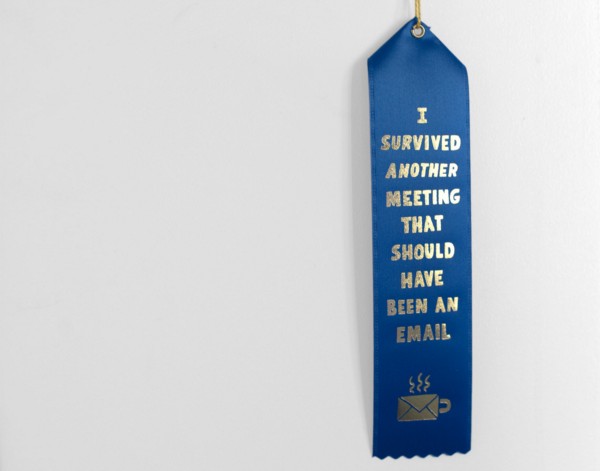It’s well known that meetings are one of the most hated aspects of any office environment, but do they have to be?

For a business owner it can be expected that meetings are simply part of the gig, whether they are being endured or a necessary part of the job is all in how they are structured — after all there are finite hours in any day and most owners and entrepreneurs are already stretched for time. Very few people enjoy meetings, largely because they are cited as a huge waste of time.
Please note it is not that I despise all meetings and some can in fact be beneficial but before calling a meeting I believe there are other steps that should be taken first.
Some of the most common reasons people hate meetings include:
- They don’t start on time
- They don’t finish on time
- Everything bar the start and the end is just filler
- People are talking just because they can, not because they have something valuable or constructive to add
It’s highly likely we’ve all walked out of a meeting and said under our breath “That’s an hour of my life I’ll never get back”. Or if you get a reminder popping up that you have a meeting in 30 minutes and feel a sense of dread wash over you, then maybe it’s time to rethink hitting the “accept” button without considering whether you are actually needed in the meeting. TED talker David Grady suggests many of us suffer from ‘Mindless Accept Syndrome’ — an involuntary reflex that makes us say “yes” to every meeting request, even if we know little about the person or their agenda.
How much do meetings cost a company per year?
Small companies can definitely look at the number of hours of lost productivity due to meetings, the larger you get the more this number will amplify. Unproductive meetings can cost a business enormously. For example, 8 people attending a meeting for an hour = 8 hours, if this is a weekly meeting then over the course of a year we’re talking up to 400 hours a year. Suppose you’re paying employees an average of $80,000 per annum which equates to $40.49 per hour. Over the course of 1 year this equals a total of $16,196 a company has spent on meetings alone. With this cost in mind the meetings had better increase productivity or correlate to revenue somehow or it’s time to reconsider how necessary a meeting is.
If you want to annoy meeting participants use the phrase “think outside the box” repeatedly
As a Saas business we have a number of different departments, none so time poor and overworked as our development department and unless absolutely necessary they will never be included in a meeting. One reason developers dislike meetings so much is that they’re on a different type of schedule from everyone else in the company. Meetings just simply cost them more and often they can be the most highly paid employees due to their specialist and sought after skills, so involving them in meetings also costs a company significantly more and means downtime in their development schedule.
Break the habit
Breaking the habit of meetings is the first step to a more productive team. With fantastic internal communication software such as Slack your team can always collaborate at any time and keep each other up to date. In fact this is the first action as an alternative to holding a meeting, pose a question on Slack and get everyone’s feedback first, swing by their desk and quickly discuss what you need an answer to. Lastly and often avoided nowadays is send an email. Email is fine when you’re asking a single person a question but beware of the assault your inbox could take if it’s a company wide email and everyone starts responding with “Reply All”.
In 2013, Dropbox executives sent out a company-wide email with the subject line ‘Ameetingeddon’. It notified employees that all recurring meetings had been deleted from their calendars. “If you check your calendar, you’ll notice that it’s feeling a bit light — at midnight we flipped the switch,” the note read. “Ahhh, doesn’t it feel fantastic?”
By removing those recurring meetings from the calendar there’s no need to have a meeting where no one really has a great deal to say. Instead time has been restored and now reserved for “catch-ups” if and when needed.
Have an agenda
A surefire way to encourage me personally to decline or “tentatively” accept a meeting invite is to send an invite with “Chat about X” or just a meeting title and no agenda or description of what we’ll be speaking about.

In fact my personal preference is to approach all meetings much like a board meeting. Boardrooms operate at the highest levels of business with the purpose of the meeting always defined with tight agendas and well-thought out time frames. I don’t want to find myself feeling sorry for the plants in the room because too many mouths are using up all the oxygen they’ve made.
Any meeting that is to be 10 minutes or more should include a time blocked agenda as a part of the description before it is sent to participants. Someone should chair the meeting and be responsible for ensuring it starts on time and everyone sticks to the agenda — ensuring that everyone’s time is being respected and you’re making the most of the time you have together.
Who needs to be there
It’s really important to consider who really needs to be present at a meeting and the participants should be broken down into:
- Required, or
- Optional
Doing this shows to your colleagues who you need in the room for the meeting to be a success and others placed under FYI may simply appreciate that you’ve considered them adding their voices too if need be.
When deciding who is to attend a meeting ask yourself these questions:
- “Do I need all of my Account Managers in the room or is this department well enough represented just by Ashley attending who can convey the important meeting action points?”, or
- “Is Danielle absolutely critical in this meeting or can I let her decide closer to the meeting date whether she needs to participate?”
Meeting duration
Whoever said that meetings always needed to be in time-blocks of 1 hour?
In fact part of the fun and challenge should be asking yourself, “What I normally do in the space of an hour, can it be done in 45 minutes?”. If you succeed in this challenge then maybe 45 minute meetings should be the norm going forward with a further challenge of knocking them down to 30 minutes.
Limiting the amount of time you have together can ensure that every minute is productive and executed efficiently. It also demonstrates respect for everyones time, so why not attempt a default meeting duration of 15 minute blocks for every 3 agenda items — essentially 5 minutes per item. By delivering meetings in this manner you are able to consider whether or not an agenda item is really needed or can be achieved via email and be more selective about the face-to-face time as you only have 5 minutes per agenda item — so make them count.
Follow-up and action points
You’ve just finished a productive 30 minute meeting and now everyone has gone back to their desks and completely forgotten all about it and simply carries on with their day. No one has any action points or tasks to follow-up? Wasn’t the point of the meeting to discuss an issue or to execute a new strategy?
What often happens in meetings is everyone becomes an artist. Creating doodles in a notepad, squiggly lines or patterns drawn around a buzz word they plucked from the meeting and no further notes taken. Whoever is chairing the meeting at the end of each agenda item should stipulate what was discussed and who needs to action it accordingly, setting a deadline also helps to ensure it’s done. If this is a laptop meeting then attendee’s can be entering in their tasks into whatever system the company has employed as a CMS or task manager as they go so they each walk away with action points, ensuring the meeting time was not wasted.
Don’t let one person dominate
If one person is going to do all of the talking and dominate the conversation then why did they ask for others to attend the meeting? The answer to this is often because their goal is to pontificate and hear themselves talk because they believe they are the smartest one in the room. It’s also highly likely they are not listening to anyone else either and will talk over others — just waiting for an opportunity to hear themselves speak again.
More often than not, this person is also a manager that takes this opportunity to assert their dominance and reinforce why they are in the role they are in. If they are your superior it might be difficult to pull them aside and let them know there are other people in the room who need to be as equally engaged. If not then it’s important they are reminded of this or the next meeting will exclude them.

Meetings absolutely have their place in any business and sometimes can be the fastest way to mutually resolve an issue and should be reserved for these purposes as much as possible. Instead of talking about what should be done, a novel idea would be to actually just do it.
The key take away here is that everyone’s time has value, being respectful of that time is greatly appreciated by everyone involved and thinking “Well if I have to do this damn meeting then I’m taking you down with me” is not the most constructive attitude, especially if you have chosen not to follow the above tips and tricks to more productive meetings.

